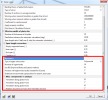Dynamic natural vibration calculation
The calculation of free vibration (determination of eigenfrequencies and eigenmodes) is carried out by means of subspace iteration. The result is the required frequencies and modes. All possible modes of vibration are affine. The amplitude can vary according to the amount of supplied energy. E.g. a guitar string may sound high or low but the frequency is the same for the basic tone as well as for higher harmonic tones. In practice, norm eigenmodes are used. The same approach is used worldwide today to adjust the scale of eigenmodes. It employs a weighted sum of squared Ä values as the norm. A mass constant M representing the weight is either the inertial mass in a node or the mass moment of inertia.
The specified masses are recalculated into nodes. By default, each member has only two end-nodes. That means that the mass is distributed into these nodes only. For structures consisting of a huge number of members, this approach leads to satisfactory results. But for structures made of a small number of members, it is necessary to increase the accuracy by means of appropriate refinement of finite element mesh.
In addition to general parameters controlling the calculation, the dynamic calculation enables the user to define additional options in solver setup:
Type of eigen value solver
The method for the calculation of eigenvalues can be selected here. Four methods are available:
The subspace iteration method was introduced by Krylov and improved by K.-J. Bathe.
The Lanczos method, which is generally faster than the subspace iteration, is described by K.-J. Bathe here.
The method denoted as „iterative ICGC“ is an internal development by A. Chirkov from Ukrainian Academy of Sciences and is destined for extremely large, especially 3D solid problems.
The method denoted as „polynomial“, is an internal development by Ivan Ševčík from FemConsulting and is based on finding roots of characteristic polynomial. It seems to be the most stable from all the suggested methods which, together with good performance, should indicate this method as the first choice. It is, however, slightly slower than Lanczos, especially on large models, which is why it is not selected by default.
Number of eigenmodes
Here the user specifies how many eigen frequencies should be calculated.
See chapter Natural vibration analysis versus mesh size.
See chapter Calculation model for dynamic analysis.
Use IRS (Improved Reduced System) method
See chapter Reduced Analysis Model
Enable advanced modal superposition for seismic load cases
Method for time history analysis
The method for the time history analysis can be selected here. Theoretical background about time-history analysis is available here. Two methods are available:
The direct time integration method uses a standard Newmark algorithm.
The modal superposition method is necessary in some cases to filter out local, high frequency modes and avoid irrelevant behaviour, typically for fast train dynamic analysis. Modal superposition is a powerful idea of obtaining solutions. It is applicable to both free vibration and forced vibration problems. The basic idea is to use free vibrations mode shapes to uncouple equations of motion. The uncoupled equations are in terms of new variables called the modal coordinates. Solution for the modal coordinates can be obtained by solving each equation independently. A superposition of modal coordinates then gives the solution of the original equations. Note: it is not necessary to use all mode shapes for most practical problems. Good approximate solutions can be obtained via superposition with only the first few mode shapes.
Mass components in analysis
This settings in solver setup is for optional removal of mass components in dynamic analysis. There are four items with checkboxes, where user can choose, which parts of mass should be taken to dynamic calculation: (as default all masses are selected)
Translation along global X axis
Translation along global Y axis
Translation along global Z axis
Rotation around local X axis of 1D members (torsion)
Calculation for selected mass combinations
If general optionSingle nonlinear analysis is ON, the user may specify which mass combinations will be calculated. Otherwise, all non-calculated are always calculated.
Note: The dynamic calculation can be carried out for mass combinations only.

